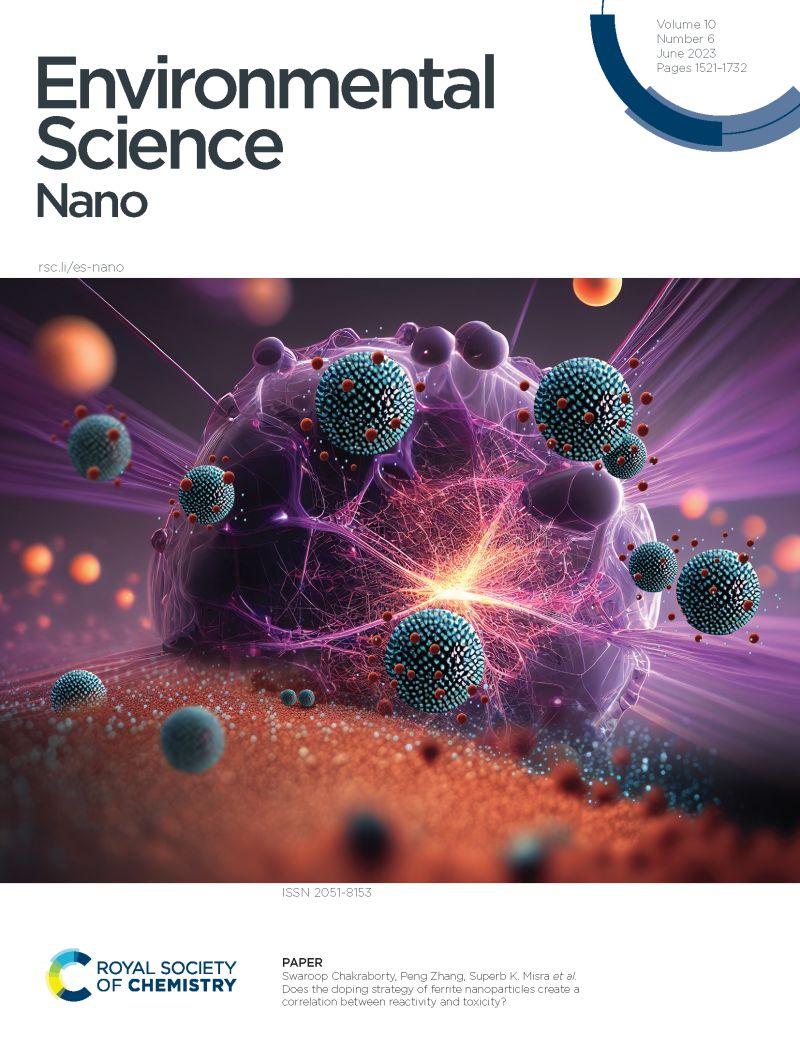二维 Mo2AlB2 过渡金属铝硼化物相整合 TiO2 纳米粒子可加速多菌灵光降解:欧姆结和电场的影响
IF 5.8
2区 环境科学与生态学
Q1 CHEMISTRY, MULTIDISCIPLINARY
引用次数: 0
摘要
在寻求高效纳米材料以克服从水中去除杀真菌剂的固有挑战的过程中,本文利用超声自组装技术,将层状二维 Mo2AlB2 与 TiO2 纳米粒子集成在一起,从而设计出一种新型欧姆结。为了探究优化复合材料(TO/15-MAB)的光物理性质,采用了一系列全面的表征方法。创新设计的欧姆结在其内部电场的促进下,通过将自由电子从 Mo2AlB2 转移到 TiO2,显著降低了 TO/15-MAB 复合材料的表面电荷。电荷的减少增强了复合材料吸引多菌灵的能力,因为它们的电荷是相反的,从而促进了多菌灵在中性 pH 条件下的快速吸附。在光照射下,结加速了电子在弯曲能带上从 TiO2 到 Mo2AlB2 的无缝过渡,减少了光生电子和空穴的重组,并将其转化为 ˙O2- 和 ˙OH。最终,15 ppm 的多菌灵被快速降解至 1 ppm,降解效率达 93.4%,降解速率 k = 0.0415 min-1,是裸 TiO2 的 4 倍。这一结论得到了实验和理论综合评估的支持。这项工作展示了 MAB 相材料在利用欧姆结和电场增强光催化方面的巨大潜力,为高效、可持续地消除水中的杀真菌剂铺平了道路。本文章由计算机程序翻译,如有差异,请以英文原文为准。

2D Mo2AlB2 transition-metal-aluminum-boride-phase-integrated TiO2 nanoparticles enable accelerated carbendazim photodegradation: impact of ohmic junctions and electric fields
In the quest for highly efficient nanomaterials to overcome the inherent challenges associated with fungicide elimination from water, herein, a novel ohmic junction was engineered by integrating layered 2D Mo2AlB2 with TiO2 nanoparticles using ultrasound self-assembly technique. A comprehensive array of characterization methods was employed to probe the photophysical properties of the optimized composite (TO/15-MAB). The innovative design of the ohmic junction, facilitated by its internal electric field, significantly reduced the surface charge in the TO/15-MAB composite by transferring free electrons from Mo2AlB2 to TiO2. This charge reduction enhanced the ability of the composite to attract carbendazim because of their opposing charges, promoting its swift adsorption under neutral pH conditions. Upon light irradiation, the junction accelerated the seamless transition of electrons from TiO2 to Mo2AlB2 over a curved energy band, reducing the recombination of photogenerated electrons and holes and converting them into ˙O2− and ˙OH. This culminated in the rapid degradation of 15 ppm carbendazim to ∼1 ppm with an efficiency of 93.4% and an enhanced rate of k = 0.0415 min−1, which is 4 times higher than that of bare TiO2. This assertion was supported by combined experimental and theoretical evaluation. This work showcases the excellent potential of MAB phase materials in harnessing ohmic junctions and electric fields for enhanced photocatalysis, paving the way for a highly efficient and sustainable approach to eliminating fungicides from water.
求助全文
通过发布文献求助,成功后即可免费获取论文全文。
去求助
来源期刊

Environmental Science: Nano
CHEMISTRY, MULTIDISCIPLINARY-ENVIRONMENTAL SCIENCES
CiteScore
12.20
自引率
5.50%
发文量
290
审稿时长
2.1 months
期刊介绍:
Environmental Science: Nano serves as a comprehensive and high-impact peer-reviewed source of information on the design and demonstration of engineered nanomaterials for environment-based applications. It also covers the interactions between engineered, natural, and incidental nanomaterials with biological and environmental systems. This scope includes, but is not limited to, the following topic areas:
Novel nanomaterial-based applications for water, air, soil, food, and energy sustainability
Nanomaterial interactions with biological systems and nanotoxicology
Environmental fate, reactivity, and transformations of nanoscale materials
Nanoscale processes in the environment
Sustainable nanotechnology including rational nanomaterial design, life cycle assessment, risk/benefit analysis
 求助内容:
求助内容: 应助结果提醒方式:
应助结果提醒方式:


